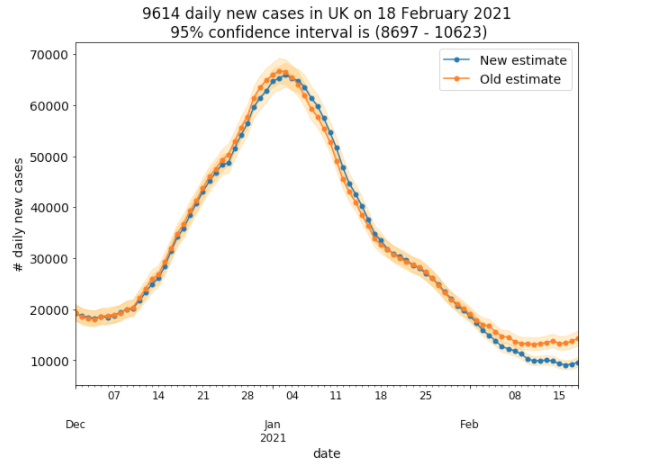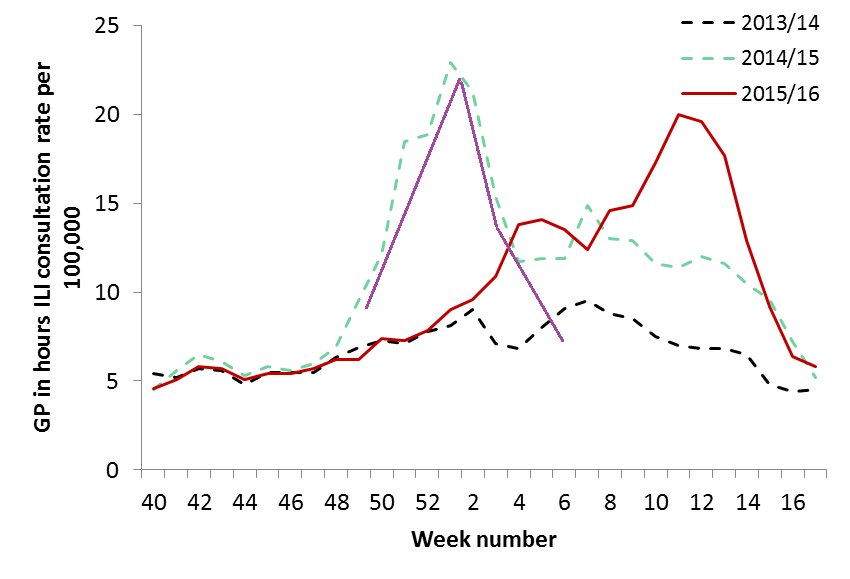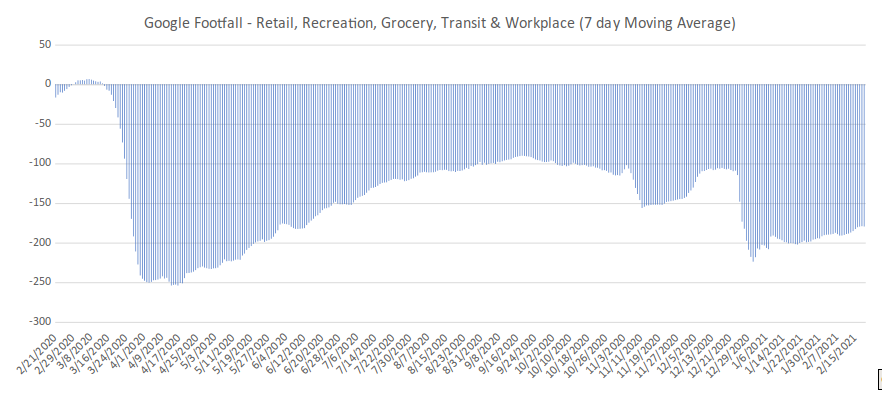In my previous piece for this site, I floated what I called “the flu hypothesis”. My idea was to treat COVID-19 like the flu to predict how it might behave. From here, we could get a sense of how Government policy might respond. This was based on the assumption that the Government policies did not really have any impact on the trajectory of the disease. So, whether the Government response ended up looking like a success or failure all depended on how the virus behaved on its own terms.
What I found was that there were two types of flu season. One was more ‘gradual’. It tended to rise slowly at the start of the year, through January and February and into March. The other type was sharper and more ‘aggressive’. This type of flu season tended to spike early, around the first week of January and burn out quicker.
Since the Government launched its lockdown policy at the start of January, I pointed out that if COVID-19 behaved like a ‘gradual’ flu season the policy would look like a failure. If, on the other hand, COVID-19 behaved like a more ‘aggressive’ flu season then it would look like it was the Government causing the decline due to their policy
How did things turn out? The best data to look at is the ZOE Symptom Tracking App.

As we can see, COVID-19 cases peaked midway through the first week of the year – on around the 4th of January. I have superimposed an approximation of this trend on a graph showing different flu season types. It is in purple and should only be read as being a rough approximation of the pattern that COVID-19 followed this year.

As we can see, COVID-19 is following the pattern – almost exactly – of a standard ‘aggressive’ flu season. Good news for the Government then!
In fact, if we look at Google footfall data, it looks even better for the Government because people stopped moving behind before the lockdown. Why? Because people stop going to shops, restaurants and transport hubs between Christmas Eve and New Year’s Day.

The true impact of the lockdown on this chart troughs on the 19th of January. But because of the holiday season people stop moving around as much on the 25th of December and the decline in footfall troughs on the 31st of December.
Well, the Government got lucky again. If we judged the lockdown based on the actual trough decline, we would see that the lockdown had full effect around the 19th of January, yet cases started coming down two weeks before that around the 4th. But because the holiday season prevented movement, the Government can claim that people stopped moving around 3 weeks before the lockdown took full effect!
The Government can do its victory lap based on a serious of two (un)fortunate events. First, COVID-19 behaved like an aggressive flu season and so peaked out much earlier than more gradual flu seasons. This gives the illusion that the lockdown had a firm and fast impact on cases.
Secondly, the Government was saved by the holiday decline in the mobility data. If we had to wait for the lockdown to kick in the dates would be off. But because people stopped moving around to celebrate the holiday season, it appears in the data that this decline in movement preceded the decline in cases.
None of this is surprising. If you read my last piece, you’ll see that I gave the Government policy a one in three chance of appearing to work by pure luck of the draw.
Most people have probably heard the phrase “correlation is not causation”. Well, this is a classic instance of just that logical fallacy. Real researchers are not fooled by spurious correlations because they deploy methods, like cross-sectional analysis, to ensure that it is clear what the underlying cause is. But the people in charge are not real researchers. They are mostly idiots with big mouths and poor analytical skills. That is why they are public health bureaucrats and not research scientists! The gormless goons you see on television occupy a bottom-feeder position in the scientific food chain.
Anyway, that’s what case growth looks like. How did COVID-19 match up to previous flu seasons in terms of excess mortality? The following table takes the peak excess mortality in each flu season since 2010. I have also included the COVID-19 outbreak in 2020, which appeared at an unusual time of the year.
| UK Flu Season Peak Excess Deaths | |
| 2010-11 | 28,519 |
| 2011-12 | 26,353 |
| 2012-13 | 38,719 |
| 2013-14 | 14,550 |
| 2014-15 | 44,377 |
| 2015-16 | 25,268 |
| 2016-17 | 33,086 |
| 2017-18 | 45,917 |
| 2018-19 | 15,564 |
| 2019-20_COVID | 74,891 |
| 2020-21 | 58,788 |
| Avg 2010-19 | 30,261 |
As we can see, the 2020-21 flu season – now dominated by COVID-19 – was the worst flu season since 2010. But was it that much worse? Not really. There were 28% more deaths than in 2017-18 and 32% more deaths than in 2014-15. I would imagine that if we had access to weekly data going back another few decades, we would easily be able to find comparable flu seasons to the COVID-19 variant of 2020-21.
The 2019-20 initial outbreak was probably comparable to the Hong Kong Flu of 1968 – an event substantial enough to get a memorable name (although no lockdown!). 2020-21 was probably more comparable to bad flu seasons that no one has even heard of because we never put a name on them.
Where do we go from here? Bad news, I’m afraid. Through a series of (un)fortunate events – most of which were predictable – the Government will be able to claim victory for their lockdown using naïve and juvenile statistical analyses of the sort that journalists love. In addition to this, the evidence is accumulating that COVID-19 is seasonal and behaves roughly like the flu.
This means that, unless something changes, the Government will probably start imposing lockdowns every year for roughly half the year from here to eternity. Welcome to Biological Police State Britain! You are no longer a citizen or a subject, but a disease vector to be controlled at the will of half-wit public health bureaucrats with PhDs posing as serious scientists.
Surely though, the vaccines will work. No? That depends on what we mean by ‘work’. The Government are now saying that for vaccines to be considered to ‘work’ “the evidence must show that vaccines are reducing hospital admissions and deaths”. Bad news for us disease vectors, because this is precisely not what is being showed in Israel.
Israeli vaccination rates in the over-60s – the group that make up around 85% of COVID-19 deaths – is approaching 90%. Over 80% of this group have been vaccinated since the end of January. Yet hospitalisations and deaths are not seeing a sharp decline. There is some seasonal decline, but it is less of a decline than we are seeing in other countries, including the UK. If their program were judged using the British Government’s criteria, based on a reduction in hospital admissions and deaths the Israeli vaccination program would be judged a failure. Maybe something weird is going on in Israel and once vaccination rates rise high enough here, we will see a big impact. But that is not what the data we have is telling us.
Pessimistic as that sounds, it is probably the most sober assessment of the data. In summary:
- COVID-19 seems to behave like an aggressive flu, peaking in the first week of the year and declining from there.
- Since the Government responds with lockdowns when cases start to increase, this gives the illusion that the lockdowns cause the cases to peak and then decline – i.e. that lockdowns work.
- Deaths from COVID-19 appear to look like a bad flu season – just bad enough that the lockdown proponents can berate their opponents for comparing it to the flu and dishonestly saying that it is much worse.
- The Government is laying out strict criteria for vaccine success that, at least based on Israeli data, are unlikely to be met.
The conclusion from this should be clear. If we do not want to live under an increasingly totalitarian police state that, like all police states, leads to economic collapse and impoverishment, then the only way out of this is to communicate clearly to the public that the most likely outcome of the Government’s plans are lockdowns forever and forced vaccinations. What is more, if the vaccine programs prove lacklustre, the Government will likely insist on more and more vaccines over time; something that will be encouraged by pharmaceutical companies who will be allowed to rake in profits while avoiding liability. Since these vaccines are rushed through testing, eventually one will likely end up being seriously toxic.
Public opinion polls showing support for the lockdowns have always been contingent on the public assumption that this is all temporary and that there is a way out. They need to understand that it is by no means clear that there is a way out – at least no way out where we declare victory over the disease due to some madcap Government scheme. The only actual way out is to admit that living in fear, subordinating ourselves to buffoons posing as saviours, is no way to live.
The author is an academic economist.












Donate
We depend on your donations to keep this site going. Please give what you can.
Donate TodayComment on this Article
You’ll need to set up an account to comment if you don’t already have one. We ask for a minimum donation of £5 if you'd like to make a comment or post in our Forums.
Sign UpLatest News
Next PostLatest News